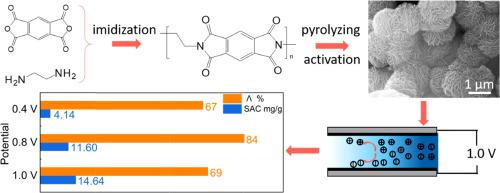Separation and Purification Technology ( IF 8.1 ) Pub Date : 2021-07-23 , DOI: 10.1016/j.seppur.2021.119336 Pengshuai Wang 1 , Wenting Ma 1 , Song Xue 1 , Liang Wang 1 , Yuan Chen 2 , Yilei Wang 1

|
The effect of electrode material’s surface morphology on capacitive deionization (CDI) has been discussed here. For more effective CDI performance, the hierarchical carbon microspheres (HCMs) with vertically aligned nanosheets are designed to obtain the roughest surface. HCMs are derived from the polyimide precursor which is formed by polymerizing methyl ethylenedicarboxylic anhydride (PMDA) with ethylenediamine (EDA) directly without any template agents. Active HCMs (A-HCMs) exhibit a specific surface area of 1870.18 m2·g−1 and a capacitance of 228.18 F·g−1 in 1 M NaCl aqueous electrolyte after carbonization and KOH activation. When processed into CDI electrodes, the vertically aligned nanosheets in A-HCMs would create continuous spaces for ion diffusion, instead of the smooth surfaces reported for other electrode materials. The meso/micro pores in nanosheets still support a large electrical double layer (EDL) for ion storage. A-HCMs exhibit a NaCl capacity of 14.64 mg·g−1 at 1.0 V in the initial concentration of 400 mg·L−1. More than 50 stable deionization/regeneration cycles could be achieved. The A-HCMs were shown to have several benefits: carbon nanosheets with micro- and meso-pores that enhance SAC, N-doped carbon for lower electric resistance and better CE, and vertically aligned nanosheets that benefit ions diffusion. We have found that macromorphology is also an effective way to optimize CDI performance in addition to controlling pore's structure.
中文翻译:

用于更有效电容去离子的 N 掺杂碳纳米片组装微球
此处讨论了电极材料表面形态对电容去离子 (CDI) 的影响。为了获得更有效的 CDI 性能,具有垂直排列的纳米片的分级碳微球 (HCM) 旨在获得最粗糙的表面。HCM 衍生自聚酰亚胺前体,该前体通过将甲基乙二甲酸酐 (PMDA) 与乙二胺 (EDA) 直接聚合而形成,无需任何模板剂。活性 HCM (A-HCM) 具有 1870.18 m 2 ·g -1的比表面积和 228.18 F·g -1的电容在碳化和 KOH 活化后的 1 M NaCl 水溶液中。当加工成 CDI 电极时,A-HCM 中垂直排列的纳米片将为离子扩散创造连续的空间,而不是其他电极材料报道的光滑表面。纳米片中的中孔/微孔仍然支持用于离子存储的大双电层 (EDL)。A-HCM在 400 mg·L -1的初始浓度下在 1.0 V 下表现出 14.64 mg·g -1的 NaCl 容量. 可以实现 50 多个稳定的去离子/再生循环。A-HCM 被证明有几个好处:具有增强 SAC 的微孔和中孔的碳纳米片,具有更低电阻和更好 CE 的 N 掺杂碳,以及有利于离子扩散的垂直排列的纳米片。我们发现,除了控制孔隙结构外,宏观形态也是优化 CDI 性能的有效方法。











































 京公网安备 11010802027423号
京公网安备 11010802027423号